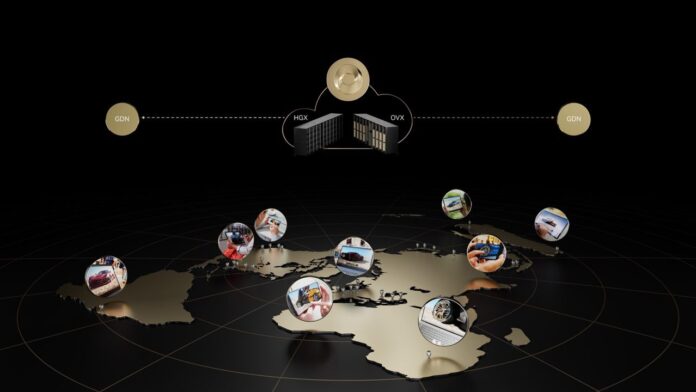Omniverse goes IaaS with new managed services and a global delivery network
Nvidia’s been pushing its metaverse concept, the Omniverse, as everything from a digital twin simulation system to a collaborative 3D playground for designers and researchers, an AI training and proving ground to make more efficient automated factories and autonomous vehicles and more. Earlier this year, Nvidia announced Omniverse Cloud, its first Infrastructure as a Service (IaaS) offering. The company offered many more details about Omniverse Cloud at its GTC developer gathering, an online event happening this week, including who’s already using it and how it will be made available to everyone.
While much of the creative potential of the Omniverse remains linked to computers equipped with Nvidia’s beefy RTX graphics hardware, Omniverse Cloud is an attempt to abstract Omniverse use from Nvidia’s hardware. The secret sauce is what Nvidia’s been doing with GeForce Now, its cloud gaming service. The company has been batting around GeForce Now in one form or another for almost the past decade, though it’s only really caught wind in the past couple of years as Nvidia has built out a global edge network capable of supporting the low latency and beefy bandwidth requirements needed to make streaming games playable.
“Omniverse is a platform for building and operating metaverse applications,” explained Jensen Huang, Nvidia CEO, who delivered a keynote address to GTC participants on Tuesday.
Omniverse leverages Universal Scene Description, a framework for exchanging 3D data originally developed by Pixar. But it’s also a complete computing platform. Nvidia counts more than 150 connectors to Omniverse developed by everyone from 3D rendering, design and content creation companies like Adobe, Autodesk and Unity to digital twin and robotics instances from companies like Siemens and Amazon.
Omniverse Cloud comprises three distinct elements, according to Huang: RTX-equipped computers used by creators, designers and engineers; servers equipped with Nvidia’s newly announced OVX computing systems, designed especially to power large-scale Omniverse digital twin instances; and what Huang and Nvidia call the Nvidia GDN, or Graphics Delivery Network.
“Through GeForce Now, we’ve built a global GDN, a Graphics Delivery Network, that reaches a hundred regions with superfast and responsive RTX graphics,” said Huang. “Whereas a Content Delivery Network, or CDN, allows internet video to be streamed efficiently, Nvidia GDN can stream interactive graphics efficiently.”
Huang described Omniverse Cloud as an Infrastructure-as-a-Service (IaaS) that runs in the cloud, on-prem, and on devices. The company is also making its Omniverse apps Replicator and Farm available in Omniverse Cloud. Replicator is the company’s synthetic data generation engine, while Farm is a scaling engine for render farms.
Besides Replicator and Farm, Omniverse Cloud will include some different services. The core Nucleus Cloud, already available to some Nvidia users through an early access program announced earlier this year, provides the core ability for designers and teams to share 3D scene and data, make changes and live edits, and more. Omniverse App Streaming makes it possible for users who don’t have RTX hardware in their devices to stream Omniverse reference apps. Nvidia has also developed Isaac Sim and Drive Sim for robotics and autonomous vehicle simulation.
Nvidia has already seeded Omniverse Cloud in the hands of early adoption partners including exotic carmaker Rimac Group, ad giant WPP, and manufacturing behemoth Siemens. The new offering will be available to other Nvidia customers in a staged early access rollout, the company said.
Nvidia and Siemens announced a collaboration earlier this year to combine Omniverse with Siemens’ own Xcelerator platforms as a way for companies to implement digital twins for industrial automation. The technology combines Siemens’ own physics-based digital models with Nvidia’s metaverse tech.
This week, the companies announced a new collaboration that will bring Siemens’ JT (Jupiter Tesselation) visualization format to Omniverse. JT is an ISO standard 3D Computer-Aided Design (CAD) data exchange format used in product lifecycle development, digital mockups and more; as a lightweight format, it is used to support interactive displays of assemblies comprising tens of thousands of individual components, making it well-suited for complicated simulations like Omniverse.
“The JT Connector opens the industrial and manufacturing worlds to Omniverse,” said Huang.
Nvidia says that Omniverse Farm, Replicator, and Isaac Sim are available today on the company’s NGC managed cloud service, for self-service deployment on Amazon Web Services (AWS). Omniverse Cloud will be available as Nvidia managed services through an early access program, the company said.

